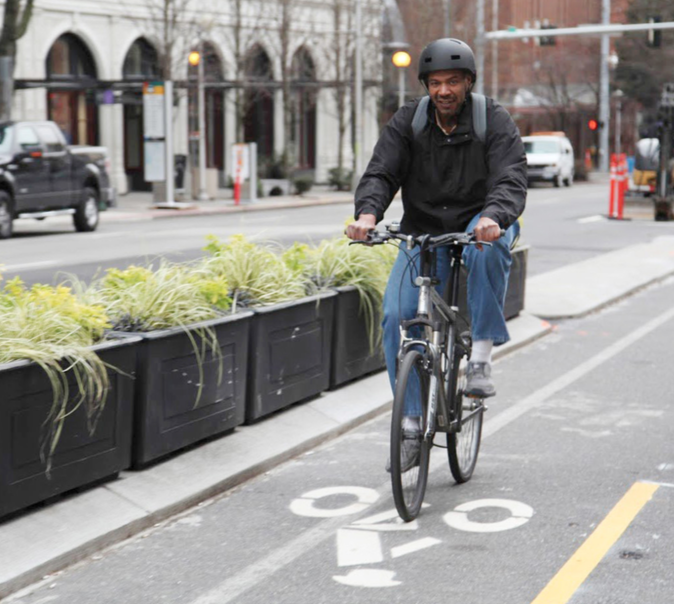8 BIG WINS for walking/rolling/biking and equity in the 2020 Seattle City Budget!
- clara
- Nov. 25, 2019
 1) Biking Routes: $10.35 million increase
1) Biking Routes: $10.35 million increase
Southeast Seattle currently does not have a single safe and convenient connection for people riding bikes to the rest of Seattle. This funding will change that, by building the Georgetown to South Park Trail, the Beacon Ave Trail, or a Martin Luther King Jr. Way South protected bike lane, or partially constructing some combination of all three! There is still more work to be done to fully bridge the $32 million gap for bike projects that were included in the 2019 Bicycle Implementation Plan (released earlier this year without allocated funding), but this is a huge step forward.

2) Walking Routes: $11 million increase
Walking and rolling is a fundamental right — but right now many people are unable to get around safely and conveniently in Seattle because of inaccessible or nonexistent sidewalks. The city's budget added $4 million for sidewalk construction and $7 million for accessibility improvements like curb ramps. This is an improvement, but we also recognize that it is a drop in the bucket the 26% of Seattle streets that don’t currently have safe places to walk, and the need for a long-term, sustainable source of funding remains.
3) Connecting to Seattle Center: $3.76 million increase
Everyone should be able to get safely and conveniently to the Seattle Center and the new arena that is opening in 2021, but right now there is no family-friendly east-west route. This funding will allow for design and partial construction of a vibrant, people-focused space on Thomas Street. This win was made possible thanks to Councilmember Sally Bagshaw's incredible leadership for this project, and support from the Seattle Parks Foundation, the Uptown Alliance, and and many others. Next year the project will undergo additional design and outreach with construction anticipated for 2021.
4. Safe Routes to School: New staff for Seattle Public Schools
Every child should be able to walk and bike to school safely, but currently there is not a single full time employee at the Seattle Public Schools in charge of making sure that happens. As a result dozens of schools lack crossing guards, and other traffic safety programs are run exclusively by volunteers (creating an equity disparity). Now thanks to the Seattle City Council there will be a full-time Active Transportation Coordinator to help the thousands of Seattle public school children who walk and bike to school arrive safely. Thank you to the School Traffic Safety Committee for their identification of this solution and continued advocacy and to Councilmember Mike O'Brien for the addition. Graphic Credit: Seattle Department of Transportation
Graphic Credit: Seattle Department of Transportation
5. Transportation Equity Program: $300,000 increase
Unfortunately, race and racism play a huge role in determining a person’s ability to get where they need to go in Seattle. Seattle Neighborhood Greenways strives to redress the historical and systemically-rooted inequities in transportation and city investments (for more see our our Racial Equity Action Plan released this year). This funding will allow continuation of the Transportation Equity Program, helping to identify and address systemic and structural equity issues.
6. Duwamish Longhouse crossing: $500,000
Right now, people cross 5 lanes with a 40 mph posted speed limit on a major truck route to get between the Duwamish Longhouse on one side of the street and Herring House Park, parking lots, and the Duwamish Trail on the other. Tour groups and school field trips are unwilling to risk the danger, which limits the Tribe's economic and engagement opportunities. This funding will cover design (but not full construction costs) and is a step towards helping people safely access this important cultural and community center. Thanks to the Duwamish Tribe for leading this effort, West Seattle Bike Connections and Duwamish Valley Safe Streets for their continued advocacy, and Councilmember Lisa Herbold for this budget addition.
7. Home Zones: $350,000
There is a 1,800 year backlog to build sidewalks across Seattle. Home Zones are a cost effective tool to make neighborhoods without sidewalks more walkable. This funding will allow continuation of the Home Zone concept that Seattle Neighborhood Greenways brought to Seattle in 2018.
8. Bike path maintenance
Seattle city council has required the Seattle Department of Transportation to present a plan on the maintenance of existing bicycle infrastructure. Currently, maintenance is reactive and complaint-based, resulting in bike routes that are hard to use, unwelcoming, and sometimes even obsolete or absent. Additionally, routes in wealthier or whiter neighborhoods are often maintained better than those in other parts of the city. When SDOT presents their draft plan, we will push for it to standardize maintenance so that the program relies less on complaints and all communities across the city can have safe and well-cared for bike infrastructure.
What didn't make it and what's next?
We also had a few disappointments: We fought hard to increase funding for Safe Routes to School and to improve Seattle's Complete Streets evaluation practices (Level of Service metrics), neither of which made it into the final balanced budget. We're not giving up on these two campaigns, and will continue to push in 2020. Please take a moment to send a Thank You to the Mayor and City Council for their support of these 2020 budget improvements by emailing jenny.durkan@seattle.gov and council@seattle.gov.Appreciate our advocacy to make our city a better place to walk, bike and live? Please donate today to keep us fighting tomorrow. Thank you.
 Photo Credit: @4SafeStreets
Photo Credit: @4SafeStreets